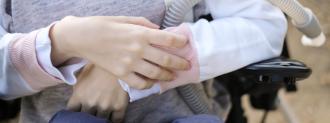In 2018, a young boy was the first person to receive a risky gene therapy for a deadly disease that weakens muscles and usually kills young patients. Now he can finally walk again — giving hope to all children suffering from Duchenne muscular dystrophy.
Conner Curran is the oldest son of Chris and Jessica Curran. But you wouldn’t guess it by looking at him. His frame looks small compared to his two brothers — one of whom is his twin.
At four years old, doctors diagnosed Conner with Duchenne muscular dystrophy, a fatal genetic disorder that causes every muscle in the body to progressively waste away. Children with the mutation that causes Duchenne muscular dystrophy — usually boys —lose their ability to walk, hold on to objects, and even smile. Most of them are confined to a wheelchair by age 12.
“While our lives were forever changed when we received Conner’s diagnosis, we’ve somehow always found our way back to hope,” Conner’s mother, Jessica Curran, told Ridgefield’s Hamelethub.
Connor’s parents, Jessica and Chris Curran, launched the organization “Kindness Over Muscular Dystrophy” to help find a cure. They call on elected officials to fund research, and through the KOMD organization, they have raised more than $800,000 for Duchenne muscular dystrophy research.
“We believe the cure is out there for Conner, and we desperately need help to fund promising research in order to find that cure for him and so many others,” Chris Curran told US Lacrosse Magazine.
Two years ago, Connor was the first to receive a new gene therapy treatment for Duchenne muscular dystrophy, which is caused by a missing or damaged dystrophin gene on the X chromosome. (Because boys have only one X chromosome, they don’t have a backup copy if one is damaged.)
The gene therapy treatment aims to replace the faulty gene with a new, functional copy by injecting him with billions of harmless, gene-carrying viruses. The viruses deliver a new copy of the dystrophin gene to his cells.
“The concept is very simple,” Jude Samulski, a pharmacologist at the University of North Carolina School of Medicine in Chapel Hill, told NPR. “You’re missing a gene, so you (put it) back.”
Samulski was on the team that initially cloned the carrier virus. That adeno-associated virus (AAV) has become the touchstone of gene therapy.
In 2001, he formed Asklepios BioPharmaceutical, where his team fabricated a condensed version of the dystrophin gene, which they used for lab research and animal studies. In 2018, he sold his research to Pfizer, who led the clinical trial with Connor and the eight other boys, showing promising results.
Connor made a remarkable recovery. Before the procedure, he could only climb a few stairs. Today, he is walking once again.
“Within three weeks, he was running up the stairs,” Jessica told NPR.
So far, only nine boys received the treatment and researchers don’t know if the treatment will have lasting effects. Pfizer is now preparing to launch a large-scale clinical trial to see if the procedure could be a life-changing solution for children with Duchenne muscular dystrophy.
We’d love to hear from you! If you have a comment about this article or if you have a tip for a future Freethink story, please email us at [email protected]






